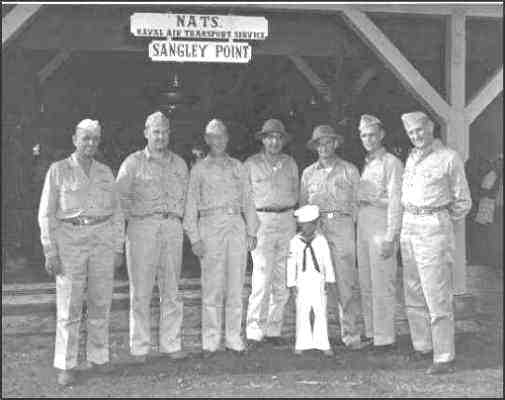

|
|
On April 16, 1945, orders came to transfer the Logistics section to Sangley Point, near Manila in the Phillipines. Capt. Fahrney could not go with the unit, so I was put in charge. We were put aboard a carrier which took about two days and two nights to get to Manila. Ashore at Sangley Point, we found the place in shambles. The Japs had been using it and our pilots had bombed it pretty thoroughly. A few buildings were left standing, but there were no windows and no doors. The natives had salvaged things after the Japs moved out. Officers were set up in a large building, partly bombed out. Capt. Fahrney and about six of us were quartered in one house. Mess was served in another house and the enlisted men were in tents. My job was to travel once a month to each island that had a Navy unit on it. I took several heads of the departments with me, to check up on the needs of the units and to expedite the movement of supplies to them. I landed on and visited many of the islands in the Phillipines. About July, 1945, Capt. Fahrney was ordered back to the States and Capt. J.W.C. Brandt took over. We called him "Just Won't Cooperate" Brandt, behnd his back of course. He was one tough and unreasonable Navy officer, just the opposite of Capt. Fahrney. About the third day after taking over, he called a meeting of all officers and said our outfit was the lousiest outfit he had ever been CO of and he was going to straighten us all out. Meantime, on July 15, 1945, I was made a full Commander. The war with Japan ended on August 14, 1945. I had charge of all civilian technicians in the area, who worked with Logistics. I had to make out orders for them, the same as for officers, so they could visit various units in the Phillipines. I made out a so-called blanket order, so they could go to one island, check and report any troubles, and then go on to another unit without further orders. One day, Capt. Brandt called me into his office and ate me out for issuing such orders. He told me to make out orders for technicians to go to certain islands, stay there a certain number of days, then go on to another island for so many days. I tried to argue him out of it, with no success. He got mad at me and ordered me back to the States. On .........., I boarded the seaplane tender ...................under Commander...................... First stop was Guam. I went ashore one evening, but couldn't find the Officer's Club. I only stayed ashore a couple of hours. Next stop was Ford Island in Hawaii. The ship received orders to proceed several hundred miles to the east and pick up a Pan Am Clipper that had landed in the ocean because of engine trouble. All of the passengers and crew had been removed. The plane was in good condition and needed to be towed to Honolulu. Arriving at the plane, the crew tried to secure lines to the plane for towing. The wind and high waves prevented this. Finally, the plane was shelled and sunk. The tender returned to Ford Island. It then proceeded to Seattle, Washington, arriving there in November, 1945. I reported in at NAS, Port Washington and was told to stand by until orders for re-assignment came from Washington, D.C. The orders came on November 27, just two days after Thanksgiving. My family was in Oakland, California, expecting and hoping to see me after 19 months in the Pacific. I had 30 days leave before reporting to Corpus Christi NAS for more duty. I was taken with a severe chest cold and tried to get the Navy doctors to extend my leave until I felt better. No Soap. I took it upon myself to stay home until after Christmas. I reported in to NAS, Corpus Christi, four days over leave time. All they did was to take that time off of my accumulated leave. I was assigned briefly as Inspection Officer. Just a month later, a regular Navy Lt. Comdr. came aboard and took over. I was next assigned as Shore Patrol Officer, with my office in Corpus Christi. It was an interesting job, but not my kind of work. On August 20, 1945, I asked to be released from active duty. My wife Loa and my daughter Jo came to Corpus Christi after my release. We then drove back to Oakland via Dayton, Detroit and Mazomanie. After retiring from active duty, my flying was confined to two weeks active duty each year at Oakland NAS. I did not fly solo as the Navy had put me in Class II which requires one to always fly with a check pilot. 1948 I retired from the Naval Reserves and did no solo flying after that. Gallery 11 

|